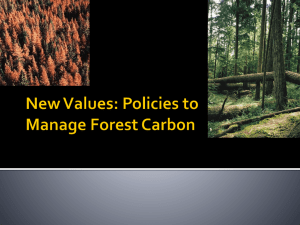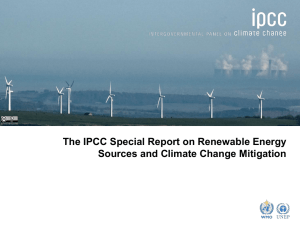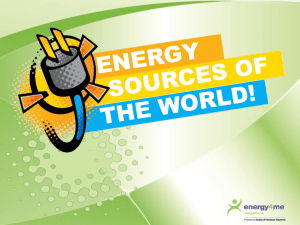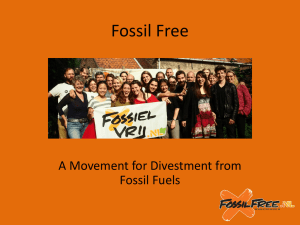View Presentation
advertisement
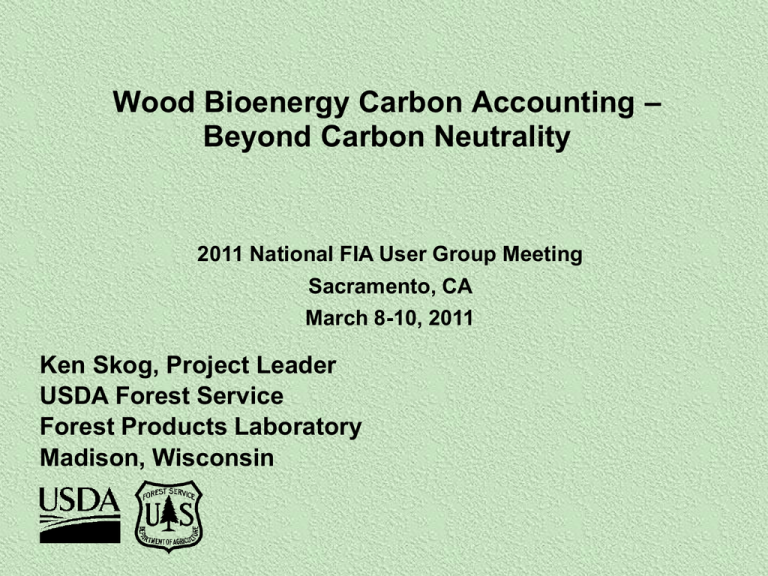
Wood Bioenergy Carbon Accounting – Beyond Carbon Neutrality 2011 National FIA User Group Meeting Sacramento, CA March 8-10, 2011 Ken Skog, Project Leader USDA Forest Service Forest Products Laboratory Madison, Wisconsin Topics What are the “right” or “helpful” research questions to ask about wood bioenergy carbon emission offsets? A Joanneum Research study – GHG offsets by wood source over time – Carbon neutrality number over time – CN(t) • Logging residue [temperate forests] • Intensified thinnings [Austria] • Intensively managed forest plantations – on fallow ag land – by clearing existing forest (if time) More forestry research questions Possible “right” or “helpful” questions (my translation of sources) Searchinger et al. – to what degree does an increase wood energy use decrease GHG emissions [over time] by alteration of forest growth/ emissions. 6/18/2010 letter from Forestry groups to EPA Administrator – Is an increase in wood energy use “good” as long as forests are managed sustainably and forest carbon is increasing? (letter says yes) Good? = less carbon emissions “overall” to the atmosphere? Manomet study – How quickly (years) and by how much will emissions from fossil fuel power system be offset by increasing use of Mass. forest biomass in selected wood-power systems? Joannuem Research – By increasing use of a specific source of wood fuel use in place of fossil fuel for power, what fraction of a fossil systems emissions would be offset by using specific wood sources in t years? Question: By increasing use of a specific source of wood fuel use in place of fossil fuel for power, what fraction of a fossil power emissions would be offset by using specific wood sources in t years? Bioenergy system Fossil fuel system Source: Giuliana Zanchi Setting up the problem - 1 Focus: – What is the emission offset of an increase in wood use ( to a new constant level) to make electric power/ heat and power Assume – kwh / kg wood carbon = kwh / kg of coal carbon – Kwh / kg natural gas carbon = 0.6 kwh / kg wood carbon Exclude emissions to obtain and transport wood or fossil fuel Setting up the problem - 2 Compute carbon neutrality number, CN(t) – Fraction of fossil emissions offset by time t by increase in wood use from a given source CN (t) = [EFF(t) – NEw(t)] / EFF(t) EFF(t) = Cumulative fossil fuel emissions avoided NEw(t) = Cumulative wood emissions to time t – Change in forest growth/ emissions due wood energy use to time t CN(t) < 1 cumulative net wood emissions > than fossil emissions CN(t) = 0 cumulative net wood emissions = fossil emissions CN(t) = 1 net wood carbon storage totally offsets fossil emissions Examples: CN(t) for wood use from 1. Additional harvest from a managed forest 2. Logging residues from a managed forest 3. New plantations on fallow land 4. New plantation after harvesting existing forest Illustrative case studies Model: GORCAM (Graz Oak Ridge Carbon Accounting Model) Growth curve based on Austrian yield table for Spruce No disturbances included 35 1.5 1.0 15 0.5 5 -5 0 50 100 150 0.0 200 250 300 350 400 CN Emissions (Gg CO2) 25 • Biomass net emissions (green) • Fossil fuel emissions (orange) • CN factor (black) -0.5 -15 Biomass Fossil Fuel -25 -1.0 CN -35 -1.5 Year Source: G. Zanchi 1. Additional fellings from a managed forest (1) Rotation period: 90 years Rotation forest: 90 hectares Harvesting: a) Baseline: 60% of increment b) New Management: 80% of increment The additional biomass is used for bioenergy C stock 50 1000 tC 40 30 20 Bioenergy system 10 Fossil fuel system (baseline) 0 -270 -180 -90 0 90 Year 180 270 360 Source: G. Zanchi 1. Additional fellings from a managed forest (2) Rotation period: 90 years Rotation forest: 90 hectares Harvesting: a) Baseline: 60% of increment b) New Management: 80% of increment The additional biomass is used for bioenergy 35 1.5 1.0 15 0.5 5 -5 0 50 100 150 0.0 200 250 300 350 400 -0.5 -15 Biomass Fossil Fuel -25 -1.0 CN Emissions (Gg CO2) 25 • Biomass net emissions (green) • Fossil fuel emissions (orange) • CN factor (black) • CN(t) = 0 at ~ t = 180 yrs • CN(400) = ~ 0.5 CN -35 -1.5 Year Source: G. Zanchi 2. Felling residues from a managed forest 30 1.5 20 1.0 10 0.5 0 0.0 400 0 50 100 150 200 250 300 350 -10 • Biomass net emissions (green) • Fossil fuel emissions (orange) • CN factor (black) CN Emissions (Gg CO2) • Rotation period: 90 years (90 ha) • Baseline: Logging residue left in the forest • New Management: 2/3 logging residue to bioenergy For a coal alternative CN(30) = 0.6 -0.5 Biomass Fossil Fuel -20 -1.0 If natural gas is the alternative CN(30 ) = 0.3 CN -30 -1.5 Year Source: G. Zanchi 3. New plantations • Baseline: low carbon change land (e.g. cropland) • New Management: new forest to produce bioenergy (no forest land use change) 100 100.0 75 10.0 25 0 0 100 200 300 1.0 400 -25 -50 -75 Fossil Fuel Biomass CN CN Emissions (Gg CO2) 50 • Biomass net emissions (green) • Fossil fuel emissions (orange) • CN factor (black) 0.1 • CN(t) >1 for all t -100 0.0 Year Source: G. Zanchi Forestry research questions for the U.S. on wood energy carbon offsets For logging residue – what is CN(t) by location? (generate U.S. map using logging residue decay curves) Are there better metrics of emission offset over time ? (e.g. relative cumulative radiative forcing – wood vs fossil fuel) CN(t) for current timber management with more thinnings, by forest type CN(t) for fire hazard reduction thinnings? CN(t) for mill residue (is landfill the alternate decay if not used? Composite products? pulp?) Are there broad management guidelines for thinnings to attain say CN(100) > 0.5? (e.g. Marland and Marland 1992) Publications Manomet study: Walker, T. (Ed.). Contributors: Cardellichio, P., Colnes, A., Gunn, J., Kittler, B., Perschel, R., Recchia, C., Saah, D., and Walker, T. 2010. Biomass Sustainability and Carbon Policy Study: Report to the Commonwealth of Massachusetts Department of Energy Resources. Manomet Center for Conservation Sciences. Report No.: NCI-2010-03. Repo A., Tuomi M., Liski J., 2010. Indirect carbon dioxide emissions from producing bioenergy from forest harvest residues. GCB Bioenergy, no. doi: 10.1111/j.1757-1707.2010.01065.x McKechnie J., Colombo S., Cheng J., Mabee W., MacLean H.L. Forest bioenergy or forest carbon? Assessing trade-offs in greenhouse gas mitigation with wood-based fuels. Environ Sci Technol. 2011 Jan 15;45(2):789-95 Palosuo T, Wihersaaari M, Liski J, 2001. Net Greenhouse Gas Emissions due to energy use of forest residues –Impacts of soil carbon balance. Woody biomass as an energy source – Challenges in Europe. EFI proceedings no 39, 2001 Schlamadinger B and Spitzer J, 1994. CO2 mitigation through bioenergy from forestry substituting fossil energy. In: Biomass for energy, environment, agriculture and industry. Proceedings of the 8th European Biomass Conference.Vienna, Austria, 3-5 October 1994, Volume 1. Ed. Chartier P., Beenackers A.A.C.M., Grassi G., pp. 310-321. Schlamadinger B, Spitzer J, Kohlmaier GH, Lüdeke M, 1995. Carbon balance of bioenergy from logging residues. Bioamss and Bioenery 8 (4): 221-234. Schlamadinger B and Marland G, 1996. The role of forest and bioenergy strategies in the global carbon cycle. Biomass and Bioenergy 10 (5/6): 275-300. Source: G. Zanchi Thank you Ken Skog – kskog@fs.fed.us 4. New plantations – existing forest is converted • Baseline: Existing forest is converted • New Management: new forest to produce bioenergy • Biomass net emissions (green) • Fossil fuel emissions (orange) • CN factor (red) • CN(t) < 0 for t < ~80 years Source: G. Zanchi
